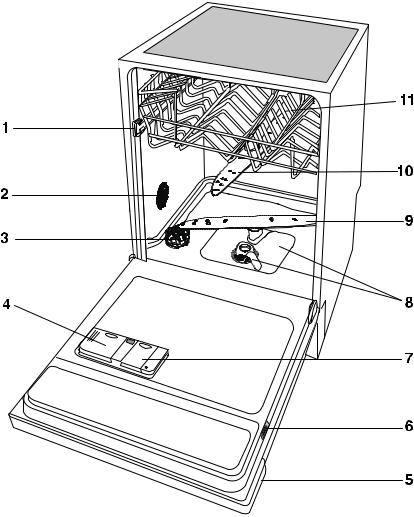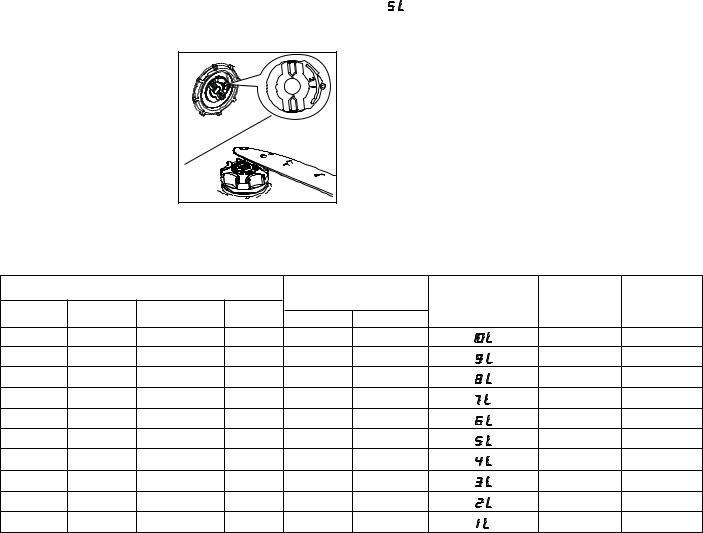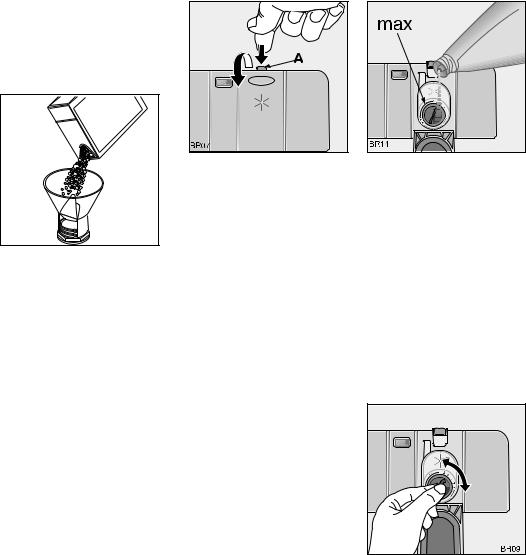Zanussi ZDT 6764 User Manual

DISHWASHER
ZDT 6764
www.zanussi.co.uk
152956 63/0 |
INSTRUCTION BOOK |
UK

Contents
Safety instructions |
3 |
Disposal |
3 |
Economical and ecological dishwashing |
3 |
Description of the appliance |
4 |
The control panel |
5 |
Audible signals |
5 |
Prior to using for the first time |
6 |
The water softener |
6 |
Filling with dishwasher salt |
7 |
Rinse aid |
7 |
In daily use |
8 |
Loading cutlery and dishes |
8 |
The lower basket |
8 |
The cutlery basket |
9 |
The upper basket |
9 |
Adjusting the height of the upper basket |
10 |
Use of detergent |
10 |
Different kinds of detergent |
11 |
Washing programmes |
12 |
Starting a washing programme |
13 |
Maintenance and cleaning |
14 |
Cleaning the filters |
14 |
Prolonged periods of non-operation |
14 |
Frost precautions |
14 |
Moving the machine |
14 |
What to do, when... |
15 |
Service and Spare Parts |
17 |
Customer Care Department |
17 |
Guarantee Conditions |
18 |
Installation instructions |
19 |
Building-in |
19 |
Levelling |
19 |
Fixing to adjacent units |
19 |
Water supply connections |
19 |
Water outlet hose connection |
20 |
Electrical connection |
20 |
Hints for test centres |
21 |
Technical specifications
Dimensions |
Width |
59.6 cm |
|
Height |
81.8 - 87.8 cm |
|
Max depth |
55.5 cm |
|
Max depth with open door |
114 cm |
|
|
|
Electrical connection: |
Information on the electrical connection is given on the rating plate on the |
|
Voltage |
inner edge of the dishwasher’s door. |
|
Overall power |
|
|
Fuse |
|
|
|
|
|
Water supply pressure |
Minimum |
50 kPa (0.5 bar) |
|
Maximum |
800 kPa (8 bar) |
|
|
|
Capacity |
|
12 place settings |
|
|
|
This appliance complies with the following E.E.C. Directives:
-73/23 or 19.2.73 (Low Voltage Directive) and subsequent modifications;
-89/336 or 3.5.89 (Electromagnetic Compatibility Directive) and subsequent modifications.
2

Safety instructions
It is most important that this instruction book should be retained with the appliance for future reference. Should the appliance be sold or transferred to another owner, or should you move house and leave the appliance, always ensure that the book is left with the appliance in order that the new owner can get to know the functioning of the appliance and the relevant safety information.
This information has been provided in the interest of your safety. You MUST read it carefully before installing or using the appliance.
If you are unsure about any aspect of the information in this book, please contact our customer care department on 08705 727 727
Installation
●Check your dishwasher for any transport damage. Never connect a damaged machine. If your dishwasher is damaged, you should contact your supplier.
●For safety reasons it is dangerous to alter the specifications or attempt to modify this product in any way.
●Any electrical and plumbing work required to install this appliance should be carried out by a qualified and competent person.
●Care must be taken to ensure that the appliance does not stand on the electrical supply cable.
●The sides of the dishwasher must never be drilled to prevent damage to hydraulic components.
Child safety
●This appliance is designed to be operated by adults.
●Children should not be allowed to tamper with the controls or play with the product.
●Packaging parts may be dangerous for children, who could even be suffocated! You should therefore keep all packaging well away from children.
●The water in your dishwasher is not for drinking. Detergent residues may still be present in your machine. Keep children well away from your dishwasher when the door is open.
●Keep all detergents in a safe place out of children's reach.
Your dishwasher in day-to-day use
●Items that are contaminated by petrol, paint, steel or iron debris, corrosive, acidic or alkaline chemicals must not be washed in this dishwasher.
●Under no circumstances should you open the door whilst the appliance is in operation, especially during the washing phase, hot water may escape. However, if the door is opened, a safety device ensures that the machine stops.
●Only use products (detergent, salt and rinse aid) specifically designed for use in dishwashers.
●Long bladed knives stored in an upright position are a potential hazard.
●Long and/or sharp items of cutlery such as carving knives must be positioned horizontally in the upper basket.
●Ensure that the door of the dishwasher is always closed when it is not being loaded or unloaded. In this way you will avoid anybody tripping over the open door and hurting themselves.
●When finishing loading or unloading close the door, as an open door can be a hazard.
●Do not sit or stand on the open door.
●Isolate the appliance from the power supply and turn off the water supply after use.
●This product should be serviced by an authorised service engineer, and only genuine spare parts should be used.
●Under no circumstances should you attempt to repair the machine yourself. Repairs carried out by inexperienced persons may cause injury or serious malfunctioning. Contact your local Service Force Centre. Always insist on genuine spare parts.
Disposal
Dispose of the dishwasher packaging material correctly. All packaging materials can be recycled.
Plastic parts are marked with standard international abbreviations:
>PE< |
for polyethylene, e.g. sheet wrapping material. |
>PS< |
for polystyrene, e.g. padding material (always CFC- |
|
free). |
>POM< |
for polyoxymethylene, e.g. plastic clips. |
Cardboard packaging is manufactured from recycled paper and should be deposited in the waste paper collection for recycling.
As and when you cease to use your dishwasher and withdraw it from service, your should render it unserviceable before having it disposed of.
Warning! Children at play could lock themselves in your dishwasher or otherwise endanger their lives. Therefore cut off the power supply cable and make the door closing device unusable to prevent children from being trapped inside.
For the disposing of the appliance please take it to a recycling centre or to your dealer who may, for a small contribution to the costs, dispose it for you.
The symbol  on the product or on its packaging indicates that this product may not be treated as household waste. Instead it shall be handed over to the applicable collection point for the recycling of electrical and electronic equipment. By ensuring this product is disposed of correctly, you will help prevent potential negative consequences for the environment and human health, which could otherwise be caused by inappropriate waste handling of this product.
on the product or on its packaging indicates that this product may not be treated as household waste. Instead it shall be handed over to the applicable collection point for the recycling of electrical and electronic equipment. By ensuring this product is disposed of correctly, you will help prevent potential negative consequences for the environment and human health, which could otherwise be caused by inappropriate waste handling of this product.
For more detailed information about recycling of this product, please contact your local city office, your household waste disposal service or the shop where you purchased the product.
Economical and ecological dishwashing
●Ensure that the water softener is correctly adjusted.
●Do not pre-wash under running water.
●Select the wash programme to suit the nature and degree of the soiling on the dishes.
●Do not use more detergent, dishwasher salt and rinse aid than is recommended in these operating instructions and by the manufacturer of the respective product.
3

Description of the appliance
1.Upper basket stop
2.Water hardness dial
3.Salt container
4.Detergent dispenser
5.Control panel
6.Rating plate
7. Rinse aid dispenser
8.Filters
9.Lower spray arm
10. Upper spray arm
11. Upper basket
IN153
4

The control panel
Function buttons
Digital display |
|
|
|
|
|
|
Delay start button |
|||||||||
|
|
|
|
|
|
|
|
|
|
|
|
|
|
|
|
|
|
|
|
|
|
|
|
|
|
|
|
|
|
|
|
|
|
|
|
|
|
|
|
|
|
|
|
|
|
|
|
|
|
|
|
|
|
|
|
|
|
|
|
|
|
|
|
|
|
|
|
|
|
|
|
|
|
|
|
|
|
|
|
|
|
|
|
|
|
|
|
|
|
|
|
|
|
|
|
|
|
|
|
|
|
|
|
|
|
|
|
|
|
|
|
|
|
|
|
|
|
|
On/Off button |
Programme selection buttons |
Indicator lights |
Half load button
Function buttons: in addition to the selection of the washing programme and the half load option, the following functions can also be set with the help of these buttons:
-water softener setting,
-the cancelling of a washing programme in progress,
-deactivation/activation of the audible signals.
Programme selection buttons: allow the selection of the desired washing programme (see "Washing programmes" chart).
«Delay start» button: this option allows the start of the programme to be delayed from 1 to 19 hours.
The digital display indicates:
-the level of hardness to which the water softener is set
-if the audible signals are activated/deactivated,
-The number corresponding to the selected washing programme,
-the delay start,
-the approximative remaining time of the running programme,
-fault codes concerning malfunction of the dishwasher.
Audible signals
Audible signals have been introduced to help indicate which operations the dishwasher is performing:
-setting of the water softener,
-end of the washing programme,
-something not working with the machine
Deactivation/activation of the audible signals
(The dishwasher must be switched off)
Factory setting: audible signals activated
1.Press the On/Off button. The indicator lights of the programme selection buttons will illuminate and in the digital display are visible 2 horizontal lines (--) (setting mode).
If other button indicator lights are on and in the digital display is visible the number of a programme (1 - 2 - 3 etc..), this means that a washing programme has been set.
The programme must be cancelled: press simultaneously the function buttons 2 and 3 for about 2 seconds, the indicator lights of the programme selection buttons will start flashing. After about 2 seconds the indicator lights of the programme selection buttons will illuminate with a fixed light and in the digital display will appear 2 horizontal lines (--) indicating that the set programme has been cancelled and the machine is now in setting mode.
Indicator lights: have the following meanings:
Salt refilling indicator light, illuminates when the salt has run out.
Rinse aid refilling indicator light, illuminates when rinse aid has run out.
End of cycle: illuminates when the washing programme has ended.
«Half load» button: this option is useful and economical when only a few dishes need washing.
Remember to load both baskets.
This option is available with some programmes (see "Washing programmes" chart).
«Half load» available |
- button activated |
|
- indicator light on |
|
|
«Half load» not available |
- button deactivated |
|
- indicator light off |
|
|
2.Press simultaneously function buttons 2 and 3, the indicator lights of the function buttons 1, 2 and 3 start flashing.
3.Press the function button 3, the indicator lights of function buttons 1 and 2 turn off while the indicator light of the function button 3 goes on flashing, the digital display indicates the current setting.
Audible signals deactivated
Audible signals activated (factory set)
4.To change the current setting, press again the function button 3, the digital display will indicate the new setting.
5.To memorise the operation, switch off the dishwasher by pressing the On/Off button or wait about 60 seconds after which the dishwasher will automatically return to setting mode.
5

Prior to using for the first time
Before using your dishwasher for the first time:
1.Ensure that the electrical and water connections comply with the installation instructions.
2.Remove all packaging from inside the appliance.
3.Set the water softener.
4.Pour 1 litre of water inside the salt container and then fill with dishwasher salt.
5.Fill the rinse aid dispenser.
The water softener
The dishwasher is equipped with a water softener designed to remove minerals and salts from the water supply, which would have a detrimental or adverse effect on the operation of the appliance.
The higher the content of these minerals and salts, the harder your water is.
Water hardness is measured in equivalent scales, Clarke degrees, French degrees (°TH) and mmol/l (millimol per litre - international unit for the hardness of water).
The softener should be adjusted according to the hardness of the water in your area. Your local Water Authority can advise you on the hardness of the water in your area.
The water softener must be set in both ways: manually, using the water hardness dial and electronically, using the function push buttons on the control panel.
a) Setting manually
1.Open the dishwasher door.
2.Remove the lower basket from the dishwasher.
3. Turn the water hardness dial to position 1 or 2 (see table).
4. Replace the lower basket.
The dishwasher is factory set at position 2.
AA07 |
b)Setting electronically
(The dishwasher must be switched off)
The dishwasher is factory set at level 5.
1.Press the On/Off button. The indicator lights of the programme selection buttons will illuminate and in the digital display are visible 2 horizontal lines (--) (setting mode).
If other button indicator lights are on and in the digital display is visible the number of a programme (1 - 2 - 3 etc..), this means that a washing programme has been set.
The programme must be cancelled: press simultaneously the function buttons 2 and 3 for about 2 seconds, the indicator lights of the programme selection buttons will start flashing. After about 2 seconds the indicator lights of the programme selection buttons will illuminate with a fixed light and in the digital display will appear 2 horizontal lines (--) indicating that the set programme has been cancelled and the machine is now in setting mode.
2.Press simultaneously function buttons 2 and 3, until the indicator lights of the function buttons 1, 2 and 3 start flashing.
3.Press the function button 1, the indicator lights of function buttons 2 and 3 turn off while the indicator light of the function button 1 goes on flashing, the digital display indicates the current level and a sequence of intermittent audible signals are heard.
The current level is indicated by the number visible in the display and the number of intermittent audible signals heard.
Example:
displayed + 5 audible signals = level 5.
4.To change the level, press function button 1. Each time the button is pressed the level changes. (For the selection of the new level see the chart).
Examples:
if the current level is 5, by pressing function button 1 once, level 6 is selected.
if the current level is 10, by pressing function button 1 once, level 1 is selected.
5.To memorise the operation, switch off the dishwasher by pressing the On/Off button or wait about 60 seconds after which the dishwasher will automatically return to setting mode.
|
Water hardness |
|
Adjusting the water |
Level indicated |
Number of |
Use |
||
Clarke |
°TH |
mmol/l |
Range |
hardness setting |
in the |
audible |
of salt |
|
manually |
electronically |
digital display |
signals |
|
||||
|
|
|
|
|
|
|
||
64 - 88 |
91 - 125 |
9,0 - 12,5 |
IV |
2 |
level 10 |
|
10 |
yes |
53 - 63 |
76 - 90 |
7,6 - 8,9 |
IV |
2 |
level 9 |
|
9 |
yes |
46 - 52 |
65 - 75 |
6,5 - 7,5 |
IV |
2 |
level 8 |
|
8 |
yes |
36 - 45 |
51 - 64 |
5,1 - 6,4 |
IV |
2 |
level 7 |
|
7 |
yes |
28 - 35 |
40 - 50 |
4,0 - 5,0 |
IV |
2 |
level 6 |
|
6 |
yes |
23 - 27 |
33 - 39 |
3,3 - 3,9 |
III |
2 |
level 5 |
|
5 |
yes |
18 - 22 |
26 - 32 |
2,6 - 3,2 |
III |
1 |
level 4 |
|
4 |
yes |
13 - 17 |
19 - 25 |
1,9 - 2,5 |
II |
1 |
level 3 |
|
3 |
yes |
5 - 12 |
7 - 18 |
0,7 - 1,8 |
I/II |
1 |
level 2 |
|
2 |
yes |
< 5 |
< 7 |
< 0,7 |
I |
1 |
level 1 |
|
1 |
no |
6

Filling with dishwasher salt
Only use salt specifically designed for use in dishwashers.
All other types of salt not specifically designed for use in a dishwasher, especially table salt, will damage the water softener.
Only fill with salt just before starting one of the complete washing programmes.
This will prevent any grains of salt or salty water, which may have been spilt, remaining on the bottom of the machine for any period of time, which may cause corrosion.
To fill:
1. Open the door, remove the lower basket and unscrew the cap of the salt container by turning it anticlockwise.
2. Pour 1 litre of water inside the container (this is necessary only before filling with salt for the first time).
3. |
Using the funnel provided, |
SALE |
|
pour in the salt until the |
|
|
container is full. |
ZOUTT |
|
SAL |
|
|
|
|
4. |
Replace the cap making |
SALZ |
SEL |
||
|
sure that there is no trace |
|
|
of salt on the screw |
|
|
thread or on the gasket. |
|
5. |
Replace on the cap tightly |
|
|
turning it clockwise until it |
|
|
stops with a click. |
SR14 |
The salt container will require topping up periodically. You are reminded of this by the salt indicator light on the control panel which comes on when the salt has finished.
The salt indicator light on the control panel can remain illuminated for 2-6 hours after the salt has been replenished, assuming the dishwasher remains switched on. If you are using salts that take longer to dissolve then this can take longer. The function of the machine is not affected.
Do not worry if water over flows from the unit when filling with salt, this is quite normal.
Rinse aid
Rinse aid is automatically added during the last rinse, ensuring thorough rinsing, and spot and streak free drying.
The dispenser, which is positioned inside the door, holds about 110 ml of rinse aid, which is sufficient for 16 - 40 dishwashing programmes, depending upon the dosage setting.
Filling with rinse aid
1.Open the container by pressing the release button (A).
2.Add the rinse aid until the container is completely full. The maximum level for filling is indicated by "max".
Ensure that the lid is closed after every refill.
Clean up any rinse aid spilt during filling with an absorbent cloth to avoid excess foaming during the next wash.
Only use branded rinse aid for dishwashers. Never fill the rinse aid dispenser with any other substances (e.g. dishwasher cleaning agent, liquid detergent). This would damage the appliance.
Adjusting the dose
According to the finish and drying results obtained, adjust the dose of rinse aid by means of the 6 position selector (position 1 minimum dosage, position 6 maximum dosage).
The dose is factory set in position 4.
Increase the dose if there are drops of water or lime spots on the dishes after washing.
Reduce it if there are sticky whitish streaks on the dishes or a bluish film on glassware or knife blades.
Top up the rinse aid when the indicator light on the control panel illuminates.
7

In daily use
●Check if it’s necessary to refill with dishwasher salt or rinse aid
●Load cutlery and dishes into the dishwasher.
●Fill with dishwasher detergent .
●Select a wash programme suitable for the cutlery and dishes.
●Start the wash programme.
Loading cutlery and dishes
Sponges, household cloths and any object that can absorb water may not be washed in the dishwasher.
●Before loading the dishes, you should:
-Remove large left-overs.
-Soften remnants of burnt food in pans
●When loading the dishes and cutlery, please note:
-Dishes and cutlery must not impede the rotation of the spray arms .
-Load hollow items such as cups, glasses, pans, etc. with the opening downwards so that water cannot collect in the container or a deep base.
-Dishes and items of cutlery must not lie inside one another, or cover each other.
-To avoid damage to glasses, they must not touch.
-Lay small objects in the cutlery basket.
●Plastic items and pans with teflon have a tendency to retain water drops; these items will not dry as well as porcelain and steel items.
For washing in the dishwasher the following cutlery/dishes
are not suitable:
-Cutlery with wooden, horn, china or mother-of-pearl handles
-Plastic items that are not heat resistant
-Older cutlery with glued parts that is not temperature resistant
-Bonded cutlery items or dishes
-Pewter or copper items
-Lead crystal glass
-Steel items subject to rusting
-Wooden platters
-Items made from synthetic fibres
are of limited suitability:
-Only wash stoneware in the dishwasher if it is specifically marked as being dishwasher-safe by the manufacturer.
-Glazed patterns may fade if machine washed frequently
-Silver and aluminium parts have a tendency to discolour during washing. Residues, e.g. egg white, egg yolk and mustard often cause discolouring and staining on silver.
Therefore always clean left-overs from silver immediately, if it is not to be washed straight after use.
-Some types of glass can become dull after a large number of washes
Open the door and slide out the baskets to load the dishes.
The rows of prongs on the lower basket can be easily lowered to allow you to load pots, pans and bowls.
The lower basket
The lower basket is designed to take saucepans, lids, plates, salad bowls, cutlery etc.
Serving dishes and large lids should be arranged around the edge of the basket, ensuring that the spray arms can turn freely.
UI94 |
UI96 |
UI88 |
8
